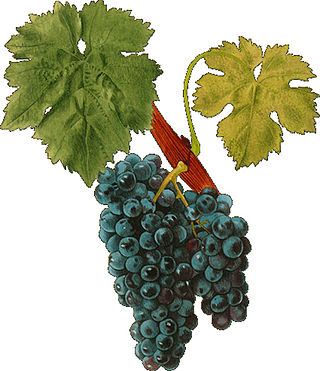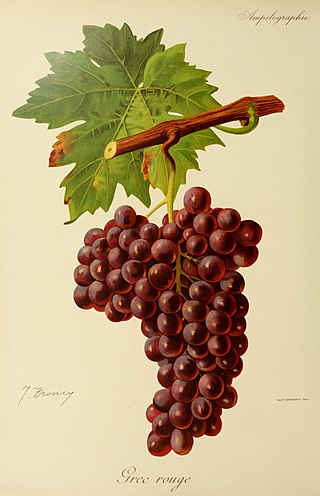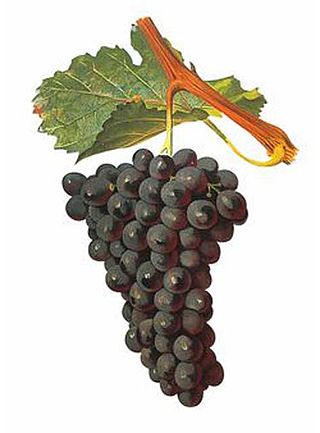
Carignan is a red grape variety of Spanish origin that is more commonly found in French wine but is widely planted throughout the western Mediterranean and around the globe. Along with Aramon, it was considered one of the main grapes responsible for France's wine lake and was a substantial producer in jug wine production in California's Central Valley but in recent years, it has been reborn as a flagship wine for many cellars in the south of France as well as in Catalonia.

Mourvèdre is a red wine grape variety grown in many regions around the world including the Rhône and Provence regions of France, the Valencia and Jumilla, Bullas and Yecla denominaciones de origen (DOs) of Spain, as well as the Balearic Islands, California and Washington and the Australian regions of South Australia and New South Wales, plus South Africa. In addition to making red varietal wines, Mourvèdre is a prominent component in "GSM" blends. The variety is also used to make rosé and port-style fortified wines.

Châteauneuf-du-Pape is a French wine, an Appellation d'origine contrôlée (AOC) located around the village of Châteauneuf-du-Pape in the Rhône wine region in southeastern France. It is one of the most renowned appellations of the southern part in the Rhône Valley, and its vineyards are located around Châteauneuf-du-Pape and in neighboring villages, Bédarrides, Courthézon and Sorgues, between Avignon and Orange. They cover slightly more than 3,200 hectares or 7,900 acres (32 km2) and produce over 110,000 hectolitres of wine a year, more wine made in this one area of the southern Rhône than in all of the northern Rhône.

Barbaroux is a pink-skinned French wine grape variety grown in southeastern France. It is a permitted variety in the appellation d'origine contrôlée wine of Cassis in Provence as well as in the Ajaccio region of Corsica. While it is sometimes known under the synonym "Barbarossa", DNA profiling has shown the Barbaroux grown in Provence is distinct from the Barbarossa vines grown in Liguria and Piedmont and is likely unrelated to all Italian Barbaross vines. There is also debate among ampelographers about whether the Barbaroux vines in Provence and Corsica are the same grape or separate Vitis vinifera varieties.

Languedoc-Roussillon wine, including the vin de pays labeled Vin de Pays d'Oc, is produced in southern France. While "Languedoc" can refer to a specific historic region of France and Northern Catalonia, usage since the 20th century has primarily referred to the northern part of the Languedoc-Roussillon region of France, an area which spans the Mediterranean coastline from the French border with Spain to the region of Provence. The area has around 700,000 acres (2,800 km2) under vines and is the single biggest wine-producing region in the world, being responsible for more than a third of France's total wine production. In 2001, the region produced more wine than the United States.

Terret noir is a dark-skinned French wine grape variety grown primarily in the Rhône valley region of France. It is a mutation of the old Vitis vinifera vine Terret. It is a permitted blending grape for Châteauneuf-du-Pape. Like the related Terret gris and Terret blanc, the vine tends to bud late and grow vigorously. Terret noir produces a light color wine that is perfumed and tart.

Piquepoul, Picpoul, or Picapoll is a variety of wine grape grown primarily in the Rhone Valley and Languedoc regions of France as well as Catalonia, Spain. It exists both in dark-skinned and light-skinned versions, as well as a very little grown Piquepoul gris. Piquepoul blanc is the most common of the Piquepouls, with 1,000 hectares cultivated in France in 2000, and an increasing trend.

Tibouren or Rossese di Dolceacqua is a red French wine grape variety that is primarily grown in Provence and Liguria but originated in Greece and possibly even the Middle East. Intensely aromatic, with an earthy bouquet that wine expert Jancis Robinson describes as garrigue, Tibouren is often used in the production of rosés.
Braquet is a red French wine grape variety grown predominantly in the Provence region of southeastern France, particularly in the Bellet Appellation d'origine contrôlée (AOC) where it is as both a blending and varietal grape in still and rosé wines. Also known as Brachet, the vine produces naturally low yields and light bodied wines that are delicately perfumed. Recent thought among ampelographers is that Braquet is not related to the more aromatic Italian wine grape of the Piedmont region known as Brachetto.

Provence (Provençal) wine comes from the French wine-producing region of Provence in southeast France. The Romans called the area provincia nostra, giving the region its name. Just south of the Alps, it was the first Roman province outside Italy.
Terret blanc is a white French wine grape variety growing primarily in the Languedoc-Roussillon region of southern France. It is a mutation of the Terret vine that also spawned the dark skinned Terret noir and light-skinned Terret gris varieties.

Brun Fourca is a red French wine grape variety that once grew widely throughout Provence and Southwest France but is now limited to small plantings within the Palette Appellation d'Origine Contrôlée (AOC).
Téoulier is a red French wine grape variety found in south east France. Ampelographers speculate that the grape may have originated around the Provençal town of Manosque due to the town's close association with several synonyms of the variety. For most of the 20th century, plantings of Téoulier have steadily declined and today is rarely found.
Merlot blanc is a white French wine grape variety that came from a natural crossing of the Bordeaux wine grape Merlot and the Cognac grape Folle blanche. The grape is distinct from Merlot gris which is a pink-skinned color mutation of the red wine grape Merlot and is sometimes used in vin gris and rosé wines. Plantings of Merlot blanc were first discovered in 1891 but cuttings of the vine have not been widely propagated and the variety is very rare. It is not used to make the sweet White Zinfandel-style wine White Merlot that is made by some California wine producers. Those wines are made from a saignee of red Merlot wine.

Œillade noire is a red French wine grape variety that has been historically grown in the Languedoc and Provence wine region but it is now close to extinction. The grape is often confused for the Rhone wine grape Cinsault which is known under the synonym œillade noire when it is sold as a table grape. It was also once thought to be a color mutation of Picardan which is known as œillade blanche and share several similar synonyms to œillade noire. However the grape has no known relation to both Cinsault and Picardan.
Bouteillan noir is a red French wine grape variety that is grown in the Provence wine region of southern France. While the grape has been recorded growing in the Vaucluse region since at least the early 18th century, today the grape is virtually extinct. Despite sharing synonyms with another Provençal grape, Calitor, and the Languedoc wine grape Aramon noir, Bouteillan noir has no known relationship with either of those variety. The white Provençal grape Colombaud was once thought to be a white berried color mutation of Bouteillan noir but research conducted by Linda Bisson of the University of California, Davis shows that while the two grapes are likely related, one is not a color mutation of the other.
Canari noir is a red French wine grape variety that has been historically grown in the Ariège department in the foothills of the French Pyrénées. However DNA profiling in 2001 showed that plantings of a grape called Gamay Luverdon growing in the Italian wine region of Piedmont were in fact plantings of Canari noir. Across the Pyrénées in Spain, the grape variety known as Batista was also found to be identical to Canari noir. Like Pinot noir and Grenache, Canari noir has color mutations known as Canari blanc and Canari gris.
Mauzac noir is a red French wine grape variety that is grown in Southwest France. Despite the similarities in name, Mauzac noir is not a color mutation of the white Limoux wine grape Mauzac that is an important component in the Appellation d'origine contrôlée (AOC) sparkling wine Blanquette de Limoux. Today Mauzac noir is nearly extinct but at least one grower in the Gaillac AOC is attempting to revive the variety and make varietal examples of the grape.
Seyval noir is a red hybrid grape variety that was created in the late 19th century by French horticulturalist Bertille Seyve and his father-in-law Victor Villard from a crossing of two Seibel grapes. The pair used the same two varieties to create the white wine grape Seyval blanc, making the two siblings rather than color mutations of one or the other. The name Seyval comes from a combination of the two men's names.
Landal noir is a red hybrid grape variety that was created during a series of trials between 1929 and 1942 by French grape breeder Pierre Landot at his Conzieu nursery in the Ain department of eastern France. The grape is a crossing of two Seibel grapes, Plantet and Seibel 8216. While authorized for use in several French wine growing region, the grape is officially not recommended for use in any quality wine production in France with only 49 hectares of the variety reported in 2008. Outside France, some plantings of Landal noir can be found in Switzerland, Canada and the United States.














